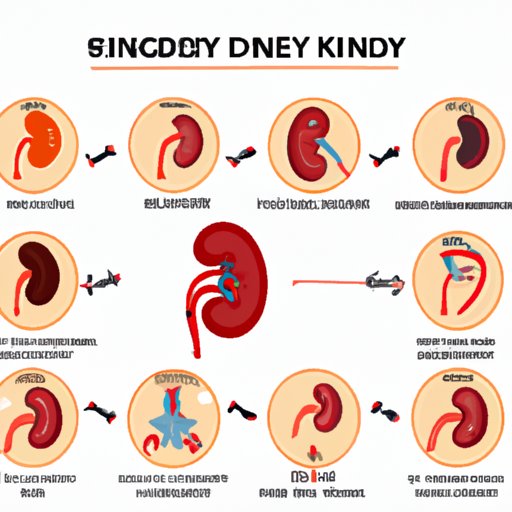
I. Introduction
Kidney disease is a common and serious health condition that affects millions of people worldwide. The kidneys are responsible for filtering waste and excess fluid from the blood, and when they are damaged, toxins can build up in the body and cause a range of health problems. Understanding the different stages of kidney disease is crucial for managing the condition and preventing further damage. In this article, we will explore the 5 stages of kidney disease, the symptoms and signs to look out for, and the available treatments for each stage.
II. Understanding the 5 Stages of Kidney Disease: A Comprehensive Guide
The 5 stages of kidney disease are categorized based on a patient’s glomerular filtration rate (GFR), which is a measure of how well the kidneys are functioning. The stages range from mild kidney damage (Stage 1) to kidney failure (Stage 5).
Stage 1: GFR greater than or equal to 90mL/min. Mild kidney damage with few or no symptoms.
Stage 2: GFR between 60-89mL/min. Mild to moderate kidney damage with mild symptoms.
Stage 3: GFR between 30-59mL/min. Moderate to severe kidney damage with noticeable symptoms.
Stage 4: GFR between 15-29mL/min. Severe kidney damage with significant symptoms.
Stage 5: GFR less than 15mL/min. Kidney failure with severe symptoms and the need for dialysis or transplant.
It is important to understand which stage of kidney disease you are in to determine the appropriate treatment plan for managing your condition.
III. The Journey Through Kidney Disease: How It Progresses in 5 Stages
Kidney disease is a progressive condition that can worsen over time if left untreated. As the disease progresses through the 5 stages, the kidneys lose their ability to filter waste and excess fluid from the blood, leading to a buildup of toxins in the body. Each stage is categorized by the severity of kidney damage and the corresponding decrease in kidney function.
With early detection and proper management, it is possible to slow down the progression of kidney disease and prevent further damage. The right treatment plan depends on the stage of kidney disease and the individual patient’s medical history and overall health.
IV. Breaking Down the Different Stages of Kidney Disease and What They Mean
When someone is diagnosed with kidney disease, it is important to understand the different stages and what they mean for the kidneys. Each stage of kidney disease is associated with certain risk factors and causes, and there are various methods to slow down the progression of the disease.
For example, some common causes of kidney disease in the early stages include high blood pressure and diabetes. In the later stages, kidney disease can be caused by chronic infections, autoimmune disorders, and certain medications.
If left untreated, kidney disease can progress rapidly, leading to a decline in kidney function and the need for dialysis or transplant. However, with proper management, it is possible to slow down the progression of kidney disease and preserve kidney function.
V. From Early Detection to Treatment: Exploring the 5 Stages of Kidney Disease
Early detection is key for managing kidney disease and preventing further damage. Routine screening tests can help detect kidney disease in its early stages, when symptoms may not be present.
In addition to waiting for symptoms to appear, there are lifestyle changes that one can make to improve kidney function. These may include eating a healthy diet, maintaining a healthy weight, quitting smoking, and exercising regularly.
The treatment plan for kidney disease depends on the stage of the disease and the individual patient’s medical history and overall health. Treatment options may include medication, dietary changes, dialysis, or transplant.
VI. Navigating the Stages of Kidney Disease: A Step-by-Step Guide to Diagnosis and Management
Diagnosing and managing kidney disease requires a collaborative effort between healthcare professionals and patients. Early diagnosis and proper management can slow down the progression of kidney disease and prevent further damage.
The diagnosis process includes several steps, including routine blood tests, urine tests, and imaging exams. After a diagnosis is made, the healthcare provider will develop a treatment plan based on the stage of kidney disease and the individual patient’s medical history and overall health.
Regular check-ups and monitoring are also crucial for managing kidney disease. This may include routine blood and urine tests, imaging exams, and consultations with a healthcare team to ensure that the treatment plan is working effectively.
VII. Conclusion
Kidney disease is a common and serious health condition that affects millions of people worldwide. Understanding the different stages of kidney disease is crucial for managing the condition and preventing further damage. With early detection and proper management, it is possible to slow down the progression of kidney disease and preserve kidney function. It is important to work collaboratively with a healthcare team to develop a treatment plan that is tailored to your individual medical history and overall health.
Remember, early detection and proper management are key to protecting your kidney health.





